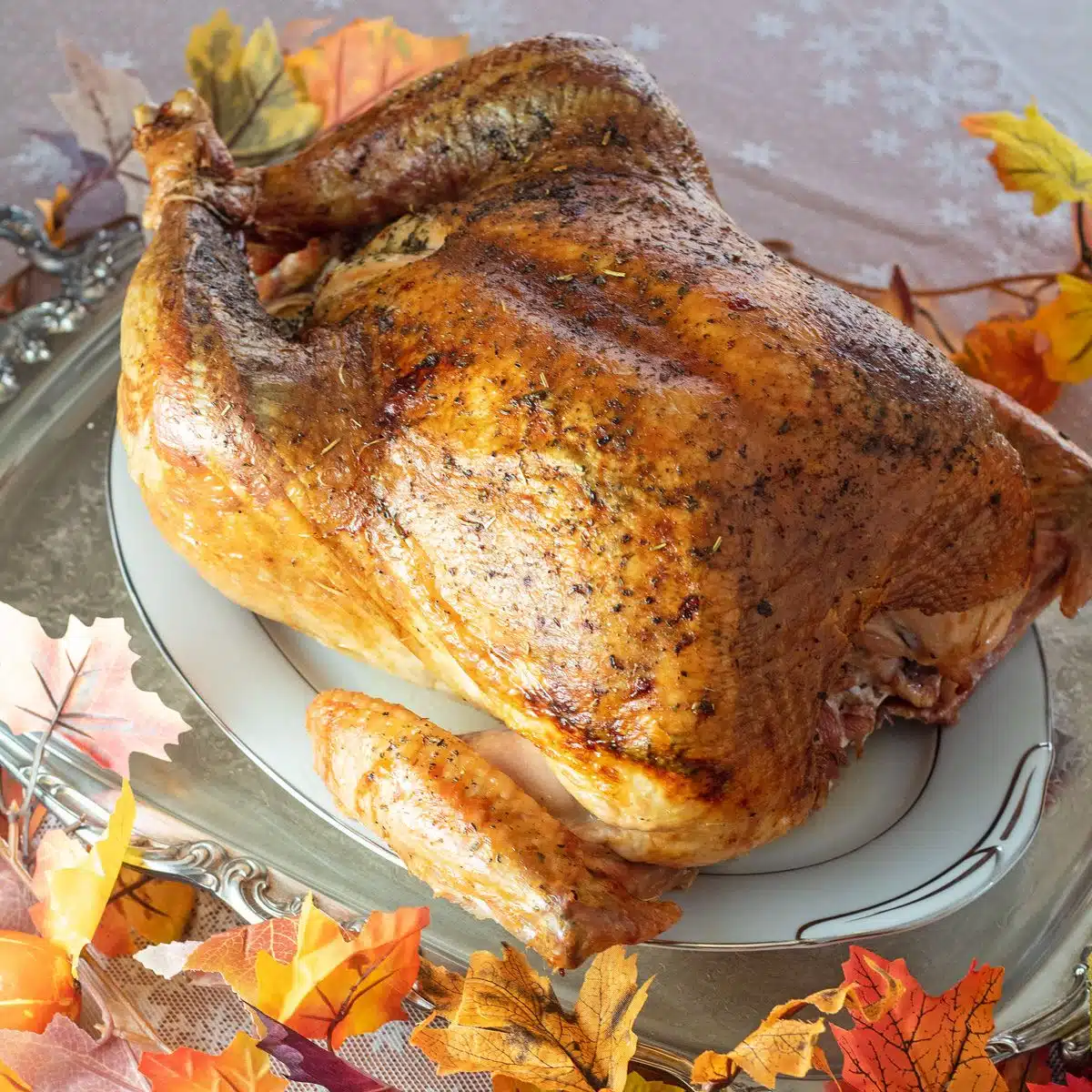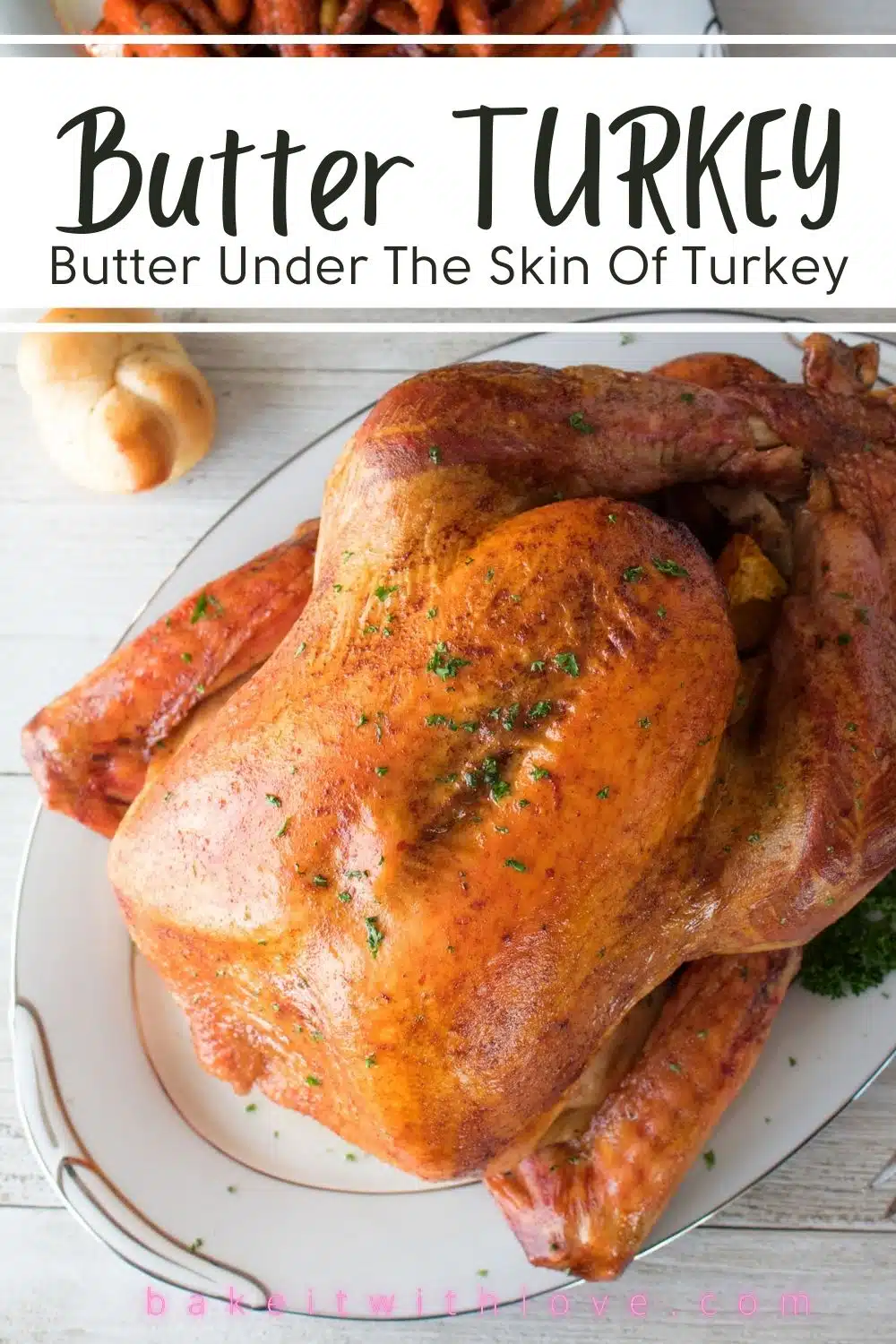Should I put butter under the skin of turkey when preparing it for a perfectly delicious Thanksgiving dinner? This post will show you all of the reasons why buttering your bird is a great idea. Plus, I will even walk you through how to stuff the butter under the turkey skin easily.
Use this guide for making oven roasted turkey, Thanksgiving, or grilled spatchcock turkey.

Jump to:
Buttering Under Your Turkey Skin
When preparing a turkey for Thanksgiving (or any occasion), we all want it to be moist, juicy, and flavorful with wonderfully crisp skin. Of course, there are a variety of different tips and tricks for making a tasty turkey.
In this article, I'm going to be answering the popular question of whether or not you should put butter under the skin of your turkey. Spoiler alert, the answer is yes!
Whether you're a pro at hosting Thanksgiving dinner and holiday parties or giving it a try for the first time this year, you're sure to find my ultimate guide to planning Thanksgiving a help! Don't forget to safely thaw your holiday turkey early, too!
What Does Butter Do
Adding butter underneath the skin of your turkey is a great way of adding in some extra moisture and reducing the likelihood of the meat drying out while it cooks. As an added bonus, it adds a rich and delicious flavor!
Should I Butter Under The Skin Of My Turkey
Since turkey is a lean protein, it is easier to overcook or dry out due to the lower fat content. No one wants to eat dry turkey.
While you can still achieve a delicious bird without the use of butter, I highly recommend adding it! It will help add moisture and flavor to the meat during the roasting process.
***As an added note, while I do recommend using butter under the skin of your turkey, I would opt for using oil on the outside of the skin. Butter may cause the skin to brown unevenly, so rubbing down the exterior of the turkey with olive oil will yield a better result.
Can I Butter Turkey In Advance
For some extra convenience, you can easily butter your turkey the night before you need to cook it! In fact, many people believe that allowing the butter to sit under the skin overnight helps it to absorb into the meat and add even more flavor!
Best Kind Of Butter To Use
Of course, you can use standard salted or unsalted butter for your turkey. Additionally, you can make a delicious butter compound for some extra flavor!
For a savory herb butter, mix together 1 cup of room temperature butter, 3 tablespoons of minced garlic, 1½ tablespoons of rosemary, 1½ tablespoons of thyme, ½ teaspoon of sage, 1½ teaspoons of salt, and ½ teaspoon of pepper.
How To Butter Under Turkey Skin
First, you'll want to gently loosen the skin of the turkey. Start at the neck end and carefully slide your fingers under the skin of the breast area, being careful not to rip the skin. Then, you can repeat the same process over both legs of the bird.
It is very important that the butter you are using is soft. Scoop some butter up with your fingers and then rub it under the loosened skin of the turkey. Typically, you'll use about 1 stick of butter.
Now you know the benefits of adding butter under the skin of your turkey! Leave a comment down below and let me know if you like preparing your turkey with butter!

📖 Helpful Cooking Guides
- How To Freeze Stuffing - If you want to prepare your stuffing in advance or save some leftovers for later, make sure you are properly storing it in the freezer.
- Add Egg To Mashed Potatoes - Learn about this interesting cooking hack for some extra rich and creamy mashed potatoes.
- Best Rice For Risotto - Make sure you are picking out the correct kind of rice for some creamy risotto.
- Yukon Gold vs Gold vs Yellow Potatoes - Take a look at the differences and similarities between these potato varieties.
- How To Safely Thaw A Turkey - Make sure you take your turkey out of the freezer in time for Thanksgiving.
- Ultimate Guide To Cooking Lamb - Find out all of the best tips and tricks for making delicious lamb dishes.
Do you love a recipe you tried? Please leave a 5-star 🌟rating in the recipe card below and/or a review in the comments section further down the page.
Stay in touch with me through social media @ Pinterest, Facebook, Instagram, or Twitter! Subscribe to the newsletter today (no spam, I promise)! Don't forget to tag me when you try one of my recipes!
📖 Recipe Card
Butter Under The Skin Of Turkey: Thanksgiving Roasted Turkey (+Tips & Tricks)
Ingredients
- 16 lb turkey (thawed)
- ½ cup butter (softened, at room temperature, divided)
- 1 medium yellow onion (peeled, halved, and quartered)
- 1 large lemon (washed, halved, and quartered)
- 1 large orange (washed, halved, and quartered)
- 1 head garlic (peeled and cloves crushed)
- ¼ teaspoon each, salt & pepper (to taste)
- ¼ teaspoon garlic powder
- ¼ teaspoon thyme
- ½ teaspoon poultry seasoning (optional)
(Note: 2x or 3x only changes the ingredient list)
Instructions
- 30 minutes before you begin, remove the turkey from the fridge so that it can come to room temperature. This is also a good time to take out the butter so it can soften.
- Preheat your oven to 450°F (230°C) and place a roasting rack or tray into a large roasting pan.
- Remove the turkey from its packaging as well as the contents of the cavity (neck, gizzards, heart, liver, and sometimes a gravy packet). Rinse both the inside and outside of your turkey and then pat it dry using paper towels.
- Transfer it to your roasting rack and generously season the interior of the turkey with salt and pepper. Then, fill the cavity with the onion, garlic cloves, orange, and lemon.
- In a small mixing bowl, add softened butter, salt, pepper, garlic powder, thyme, and optional poultry seasoning if using. Mix until well combined.
- Gently loosen the skin of the turkey with your fingertips and spread half of the herb butter under the skin, covering the breast and legs.
- Tuck the wing tips under and use butcher twine to hold the legs together. Spread the remaining herb butter all over the entire outside of the turkey, including all sides.
- Leave your turkey uncovered and place it in the preheated oven. Then, reduce the temperature of the oven to 350°F (175°C) and cook for 13 minutes per pound (with no stuffing) or 15 minutes per pound (with stuffing).
- Remove your turkey from the oven and baste it using the drippings from the pan every 45 minutes. Keep your oven closed while you are basting the turkey so that the temperature stays steady.
- Remove your turkey from the oven when it reaches 155-160°F (68-71°C).
- Carefully transfer the cooked turkey to a cutting board or your serving platter, then cover loosely with aluminum foil. Save the drippings for gravy (if desired). Allow your turkey to rest for about 1 hour before carving and serving.
Notes
- Take a look at my guide for how to safely thaw turkey for some tips and tricks!
- Allowing your turkey to come to room temperature will help it to cook evenly and minimize shrinkage.
- An unstuffed turkey cooks at about 13 minutes per pound. However, since the cavity is stuffed with oranges, lemons, onions, and garlic, it will take slightly longer to cook at about 15 minutes per pound.
- Turkey should never be cooked at a temperature that is lower than 325°F (163°C) due to safety.
- If the presentation of your turkey is not vital, you can achieve an incredibly moist turkey breast by cooking the bird with the breast side facing down.
- The hardest spot to get to cook evenly with your turkey is the thigh joint, to help with this don't tie the legs together, and you can even use a sharp knife to cut deeper into the joint. This will cook your turkey evenly, quickly, and perfectly.
- To store: Remove the meat from the turkey and transfer it to an airtight container. Keep it in the fridge for up to 4 days.
- To freeze: You can place your meat into zip-top freezer bags and freeze them for up to 3 months.
- To reheat: Place your meat into a baking dish with some chicken broth and butter then cover with aluminum foil. Bake in the oven at 350°F (175°C) until heated all the way through.



Comments
No Comments